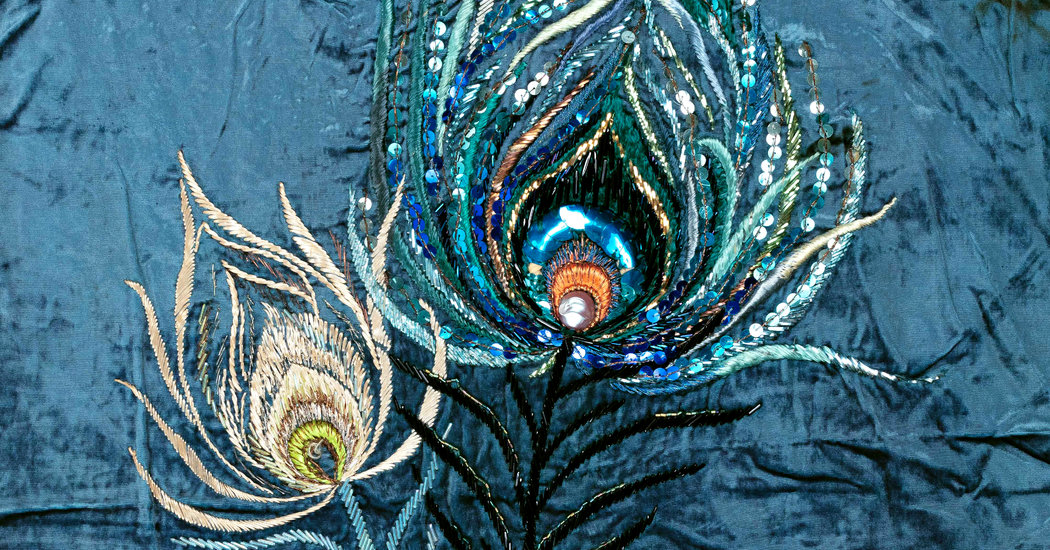
PARIS — Call it the most exciting fashion auction that wasn’t.
On Wednesday, the day after the Chanel and Louis Vuitton women’s wear shows brought the spring 2019 ready-to-wear season to an end, a sale had been scheduled for a private collection of embroideries from the historic houses of Lesage and Michonet — said to be the largest such collection ever available to the public.
In the weeks before the event, Alix Laurent-Bellue, the curator in charge of the sale for the auction house Leclere, said she had never fielded so many phone calls. People in the business, she added, were astonished by what was going on the block.
It was both history and potential inspiration, antiquities of the artisanal kind.
The samples — 453 in all, ranging from palm sized to the length of a gown skirt — spanned the history of modern fashion. The oldest came from the 19th-century embroiderer Maison Michonet, which was active at the time of Charles Frederick Worth, the official dressmaker to Empress Eugénie of France and was considered by many to be the father of haute couture. The most recent dated to 1989.
But on Sept. 28 there were rumblings of backstage drama. A spokesman for Leclere said that Chanel, which bought Lesage in 2002 through its subsidiary, Paraffection, had offered 150,000 euros ($174,000) for the collection, but the seller had rejected it. The auction’s top estimate was €180,000.
Negotiations continued through the weekend and, by Monday evening, the deal was done.
An email from Lesage said the sale would not take place because, through Leclere, it had reached an agreement with the seller. Philippe Gaultier, a partner at the legal firm Legrand Lesage-Catel Gaultier, which advises Leclere, said that such friendly agreements were a common outcome of negotiations. (There is no family relationship between the law firm and the embroiderer Lesage.)
Had the auction previews been held as scheduled, the public would have had a chance to survey 20th-century style rendered in meticulous needlework. Among the samples were embroideries created for Madeleine Vionnet, Elsa Schiaparelli, Cristóbal Balenciaga, Pierre Balmain, Coco Chanel, Christian Dior, Yves Saint Laurent, Hubert de Givenchy and Christian Lacroix. Jacques Fath, Jean Patou and Jean-Louis Scherrer, designers whose names live on through fragrance franchises, were represented. So were a few maisons that would be familiar primarily to fashion historians, like Agnès-Drecoll and Jean Dessès.
The sale — billed as only the second time that Lesage pieces would come to auction — also would have put the fledgling auction house, founded in 2006, and its nascent fashion department on the map.
But the story illustrates the lengths to which heritage houses such as Maison Lesage will go to protect their savoir-faire and heritage. Didier Ludot, a vintage clothing expert based in Paris, said that business had picked up significantly in the past two years for key couture pieces by Chanel, Dior, Saint Laurent and Balenciaga. The ready-to-wear houses Burberry and MaxMara are known to be expanding their archives, too.
Mr. Ludot said he recently sold to Chanel an outfit that had appeared on the cover of French Vogue in the 1960s. He added that he had received inquiries from Givenchy, and from Dior for clothes from Gianfranco Ferré’s seven-year tenure, in the late 1980s and early ‘90s.
Guillaume Henry, the designer who left Nina Ricci last spring and has been named to revive the Jean Patou label, also stopped by Mr. Ludot’s store in recent weeks. “I’m always happy when pieces go back home,” the dealer said.
So what did the public miss at auction? Just 10 days ago, Ms. Laurent-Bellue was working with an assistant in a conference room at Leclere’s Paris offices, sorting embroideries into large labeled cardboard boxes. There was also a mystery pile of pieces for which there were dates — a heavy velvet with floral embroidery from 1890, a Jazz Age motif — but no provenance.
“François Lesage used to say that embroidery was like the fireworks on Bastille Day,” Ms. Laurent-Bellue told a reporter as she pulled out a sequined landscape made for Valentino, and a bouquet of beads, sequins and gold leather on satin-lined lace once used by Lacroix. Some of the techniques that Mr. Lesage invented, like beading in gradations of color for Vionnet, are back in style now. Others, such as thermo-folded nylon florals for Fath, pleated raffia flowers for Givenchy or, for Saint Laurent, van Gogh-inspired flora with leather inserts, still looked fresh, even though they might be more than half a century old.
Mr. Lesage ran the family business for 62 years, until his death in 2011. A generous man, he often gave samples to his closest collaborators — among them the seller, who wished to remain anonymous. Mr. Ludot said that when Mr. Lesage was invited to a dinner party, he often brought a sample as a gift to his host.
As antiques go, the prices would have been accessible, starting at €50 for 1950s-era ornamental pieces, such as stylized flowers in beads, sequins and pink feathers on mauve satin that had no confirmed connection to a fashion house. Estimates increased to €1,000 to €1,200 for lots such as a panel of mallard-blue velvet embroidered for Vionnet before 1924 with a pair of peacock feathers in rocaille, sequins and metal thread. The 1940s-era acorn motif on shocking pink velvet, pictured on the cover of the now-obsolete sale brochure, and a purple sequined foxglove motif from around 1939, both made for Schiaparelli, had been expected to fetch the highest prices because of Mr. Lesage’s close friendship with the designer. He also was close to Vionnet and Chanel.
But it was not to be. “I showed up in jeans today, ready to hang the preview,” Ms. Laurent-Bellue said. “Then Chanel made an offer the seller couldn’t refuse.”







